
 |
THE FOURTH INTERNATIONAL
|
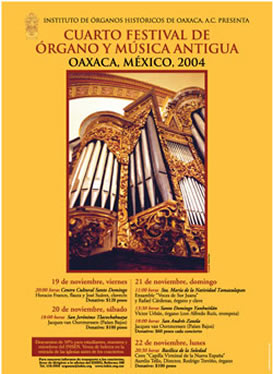 |
 |
This year marked the fourth consecutive year of the IOHIO Festival and the first time that the festival was divided into two parts. In total, nine concerts for organ and early music ensembles were presented in November 2004 and March 2005. The IOHIO has always used the organs located in Tlacochahuaya, the Cathedral, Zautla, La Soledad and Yanhuitlán in our festival concerts. But this year for the first time we also included the organ in Santa Maria Tamazulapan, which had been previously omitted because of its location two hours distant from the city of Oaxaca.
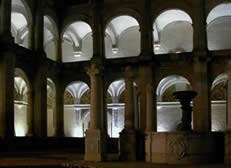 November 19 The Fourth Festival was inaugurated with an extraordinary concert by Mexican baroque flutist Horacio Franco and harpsichordist José Suárez in the Santo Domingo Cultural Center. The atmosphere is always highl
November 19 The Fourth Festival was inaugurated with an extraordinary concert by Mexican baroque flutist Horacio Franco and harpsichordist José Suárez in the Santo Domingo Cultural Center. The atmosphere is always highl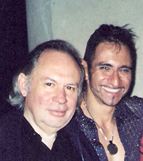 y charged when this duo performs: Franco has become one of Mexico´s performance superstars and Suárez is regarded as Mexico´s expert in historic keyboard repertoire. The concert consisted of perfectly executed baroque gems by Telemann, Handel, Corelli and Bach, including a solo by each performer. Because of the extraordinary acoustics in this sixteenth-century Dominican convent, one of Oaxaca´s architectural treasures, the delicate sounds of the flute and harpsichord carried to the farthest corners of the cloister.
y charged when this duo performs: Franco has become one of Mexico´s performance superstars and Suárez is regarded as Mexico´s expert in historic keyboard repertoire. The concert consisted of perfectly executed baroque gems by Telemann, Handel, Corelli and Bach, including a solo by each performer. Because of the extraordinary acoustics in this sixteenth-century Dominican convent, one of Oaxaca´s architectural treasures, the delicate sounds of the flute and harpsichord carried to the farthest corners of the cloister.

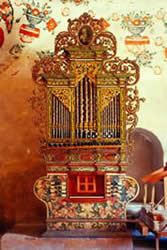 November 20 The second concert of the festival was presented in San Jerónimo Tlacochahuaya by Jacques van Oortmerssen, organ professor in the Amsterdam Conservatory, and was comprised mainly of North German and Dutch music, which were amazingly compatible with this organ. In fact, van Oortmerssen believes that the Oaxacan organs are not specifically Iberian-style, but rather represent a more generalized type of construction which predated the separation of national organbuilding styles in Europe. His program ended with an improvisation on the Oaxacan folk song “La Canción Mixteca,” which had been scribbled out for him just ten minutes before the concert began and which endeared him to his local audience. As is customary after the concerts in Tlacochahuaya, the heartier members of the audience climbed up the winding stone staircase to the choir loft to have a closer look at the organ and to listen to Susan Tattershall´s talk about its restoration in 1991. Upon exiting the church into the fresh evening air, festival participants were greeted by a committee of local women who are always on hand after our concerts to offer regional snacks and beverages.
November 20 The second concert of the festival was presented in San Jerónimo Tlacochahuaya by Jacques van Oortmerssen, organ professor in the Amsterdam Conservatory, and was comprised mainly of North German and Dutch music, which were amazingly compatible with this organ. In fact, van Oortmerssen believes that the Oaxacan organs are not specifically Iberian-style, but rather represent a more generalized type of construction which predated the separation of national organbuilding styles in Europe. His program ended with an improvisation on the Oaxacan folk song “La Canción Mixteca,” which had been scribbled out for him just ten minutes before the concert began and which endeared him to his local audience. As is customary after the concerts in Tlacochahuaya, the heartier members of the audience climbed up the winding stone staircase to the choir loft to have a closer look at the organ and to listen to Susan Tattershall´s talk about its restoration in 1991. Upon exiting the church into the fresh evening air, festival participants were greeted by a committee of local women who are always on hand after our concerts to offer regional snacks and beverages.
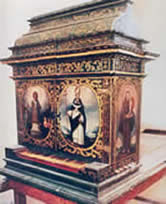
November 21 This day was an organ marathon, with three concerts programmed in three different geographical areas of the state. For the first time, a IOHIO festival concert was presented in Santa María de la Natividad Tamazulapan, two hours away from Oaxaca City. Here the little two-foot processional organ, one of the smallest in Oaxaca, is situated in a high right-hand balcony. Although the organ bears no date, it appears to have been built around 1725-30 because of characteristics shared with instruments which are dated from that period. Exquisitely painted with images of four saints, this jewel of an organ sits on a table with its two historic bellows behind. All the pipes and the keyboard were rebuilt during the 1996 restoration directed by Susan Tattershall, an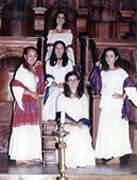 d amazingly enough, the robust voice of this instrument, disproportionate to its small size, is stro
d amazingly enough, the robust voice of this instrument, disproportionate to its small size, is stro ng enough to fill the huge nave of the church. From the upper balcony, Mexican organist and harpsichordist Rafael Cárdenas played organ works by Spanish composers, while down below in the church, the five young women of the baroque ensemble “Voces de Sor Juana” sang Latin motets and Spanish secular songs, engagingly acted out and sometimes in alternation with the organ. The IOHIO´s new spinet, built in Mexico City by harpsichord builder Alejando Vélez, was proudly inaugurated during this concert.
ng enough to fill the huge nave of the church. From the upper balcony, Mexican organist and harpsichordist Rafael Cárdenas played organ works by Spanish composers, while down below in the church, the five young women of the baroque ensemble “Voces de Sor Juana” sang Latin motets and Spanish secular songs, engagingly acted out and sometimes in alternation with the organ. The IOHIO´s new spinet, built in Mexico City by harpsichord builder Alejando Vélez, was proudly inaugurated during this concert.
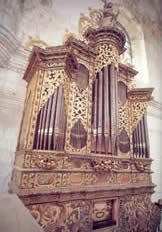 We then proceeded to Santo Domingo Yanhuitlán to hear organist Víctor Urbán, one of Mexico´s legendary organ teachers from the Institute of Sacred Music in Toluca. His program included a broad spectrum of works by Spanish, Italian and English composers from the sixteenth to eighteenth centuries, which demonstrated the rich and varied registrations of the organ. He was accompanied in several of the
pieces by local trumpet player Alfredo Ruiz. The
We then proceeded to Santo Domingo Yanhuitlán to hear organist Víctor Urbán, one of Mexico´s legendary organ teachers from the Institute of Sacred Music in Toluca. His program included a broad spectrum of works by Spanish, Italian and English composers from the sixteenth to eighteenth centuries, which demonstrated the rich and varied registrations of the organ. He was accompanied in several of the
pieces by local trumpet player Alfredo Ruiz. The 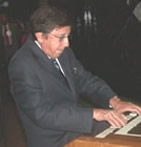 imposing sixteenth-century Dominican convent complex in Yanhuitlán dominates the surrounding landscape, and the church contains some of the most notable colonial paintings and altarpieces in Mexico. As in most all the colonial stone monuments, the acoustics are splendid. The organ, opulently decorated with Dominican symbols, swirling designs, and even phantasmagorical birds, shows characteristics of having been built around 1700. It was restored in 1998 by the French organbuilder Pascal Quiorin.
imposing sixteenth-century Dominican convent complex in Yanhuitlán dominates the surrounding landscape, and the church contains some of the most notable colonial paintings and altarpieces in Mexico. As in most all the colonial stone monuments, the acoustics are splendid. The organ, opulently decorated with Dominican symbols, swirling designs, and even phantasmagorical birds, shows characteristics of having been built around 1700. It was restored in 1998 by the French organbuilder Pascal Quiorin.
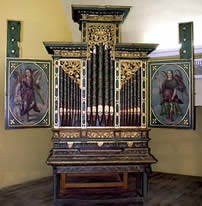 After a delicious meal of Oaxacan mole negro and mezcal in the patio behind the church of San Andrés Zautla, we filed into the charming church to hear another masterful concert by Jacques van Oortmerssen. Once again his program focused on the North German and Dutch repertoire and ended with another improvisation on a Oaxacan folk song, this time “Mi
After a delicious meal of Oaxacan mole negro and mezcal in the patio behind the church of San Andrés Zautla, we filed into the charming church to hear another masterful concert by Jacques van Oortmerssen. Once again his program focused on the North German and Dutch repertoire and ended with another improvisation on a Oaxacan folk song, this time “Mi  Linda Oaxaca.” The organ, whose construction date of 1726 is incised on the front central pipe, is painted with finely-rendered images of the four archangels on both sides of the doors and St. Peter and St. Andrew on the sides, gold, green, and black border designs, opulent gilding, and polychromed grotesque faces on the façade pipes. It is of medium dimensions and even though it sits on a table, is too big and unwieldy to ever have been portable. After the concert, the audience, which always includes lots of local people, filed up to the small wooden choir loft in groups to see the organ up close, have their picture taken in front of it, and hear about its restoration in 1997 by Susan Tattershall.
Linda Oaxaca.” The organ, whose construction date of 1726 is incised on the front central pipe, is painted with finely-rendered images of the four archangels on both sides of the doors and St. Peter and St. Andrew on the sides, gold, green, and black border designs, opulent gilding, and polychromed grotesque faces on the façade pipes. It is of medium dimensions and even though it sits on a table, is too big and unwieldy to ever have been portable. After the concert, the audience, which always includes lots of local people, filed up to the small wooden choir loft in groups to see the organ up close, have their picture taken in front of it, and hear about its restoration in 1997 by Susan Tattershall.
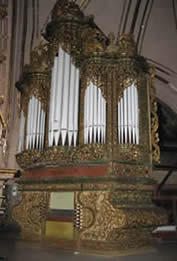
November 22 The festival came to a grand conclusion in the Basílica de la Soledad on the day of St. Cecilia, patron saint of musicians. In this performance, the organ functioned as a continuo to accompany the ensemble “Capilla Virreinal de la Nueva España,” a group dedicated to presenting and promoting music from colonial Mexico and Latin America. Aurelio Tello, the director of the chorus, had in fact catalogued and published many of the works presented in the program, including pieces by Gaspar Fernández, whose seventeenth century collection of over three hundred pieces is in the Oaxaca Cathedral, and by Manuel de Sumaya, chapelmaster (maestro de capilla) in the Cathedral from 1745-55. Restored in 1999 by Pieter Visser and Ignacio Zapata, this monumental organ bears an inscription with the date 1686 on the left side of the case, although 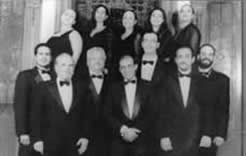 the pipes and other phonic components appear to date from the eighteenth century. About a century ago the original elaborate decoration on the case was covered with dull greenish-gray paint, presumably to create a cooler, cleaner look in accordance with the prevailing neo-classic aesthetic. Nowadays such “updating” would be unthinkable and luckily this later paint layer was removed during the recent restoration.
the pipes and other phonic components appear to date from the eighteenth century. About a century ago the original elaborate decoration on the case was covered with dull greenish-gray paint, presumably to create a cooler, cleaner look in accordance with the prevailing neo-classic aesthetic. Nowadays such “updating” would be unthinkable and luckily this later paint layer was removed during the recent restoration.
---------------------------------------------------
The second part of the Fourth Festival was organized to compliment the visit to Oaxaca of the eminent Italian organist and scholar, Luigi Ferdinando Tagliavini and offered three concerts, two lectures, and two field trips.
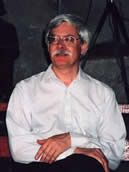 March 11 The first concert of the spring part of the Fourth Festival was presented in the Oaxaca Cathedral by the American organist Robert Bates. Bates has recently recorded the entire repertoire of the seventeenth-century Sevillan organist Francisco Correa de
March 11 The first concert of the spring part of the Fourth Festival was presented in the Oaxaca Cathedral by the American organist Robert Bates. Bates has recently recorded the entire repertoire of the seventeenth-century Sevillan organist Francisco Correa de
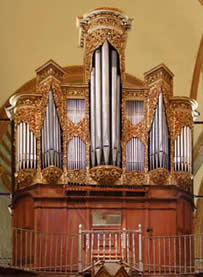 Arauxo, and his program highlighted works by this composer as well as Cabanilles, Sweelinck and Scheidt. His playing was at once elegant and dazzling, and in the virtuoso passages of the tientos (a general term meaning “pieces”), his hands seemed to fly over the keys. Because the Cathedral is located right on the main plaza (zócalo) of Oaxaca, there is frequently competing background noise during concerts, though this time we were lucky that it wasn´t a rock band or a political demonstration. The organ is principally of early eighteenth-century construction, though it includes many different phases of construction and interventions over the years, with some pipes dating perhaps to the seventeenth century. Its upper case, elaborately carved and gilded, dates from the early eighteenth century, according to archival evidence, but its lower case was rebuilt during the 1997 reconstruction by Susan Tattershall, because it had been irreparably damaged by woodworm.
Arauxo, and his program highlighted works by this composer as well as Cabanilles, Sweelinck and Scheidt. His playing was at once elegant and dazzling, and in the virtuoso passages of the tientos (a general term meaning “pieces”), his hands seemed to fly over the keys. Because the Cathedral is located right on the main plaza (zócalo) of Oaxaca, there is frequently competing background noise during concerts, though this time we were lucky that it wasn´t a rock band or a political demonstration. The organ is principally of early eighteenth-century construction, though it includes many different phases of construction and interventions over the years, with some pipes dating perhaps to the seventeenth century. Its upper case, elaborately carved and gilded, dates from the early eighteenth century, according to archival evidence, but its lower case was rebuilt during the 1997 reconstruction by Susan Tattershall, because it had been irreparably damaged by woodworm.
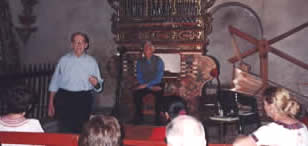 March 12 During two discussion sessions in the choir loft of the Tlacochahuaya church, Ferdinando Tagliavini shared his extensive knowledge of Italian and Spanish organ practice with a group of approximately twenty-five organ aficionados. The first talk, “Francisco Correa de Arauxo and the ´Tiento de Medio Registro´,” focused on performance practice of the tientos and the use of the divided register. Robert Bates was on hand for a musical demonstration from some representative pieces.
March 12 During two discussion sessions in the choir loft of the Tlacochahuaya church, Ferdinando Tagliavini shared his extensive knowledge of Italian and Spanish organ practice with a group of approximately twenty-five organ aficionados. The first talk, “Francisco Correa de Arauxo and the ´Tiento de Medio Registro´,” focused on performance practice of the tientos and the use of the divided register. Robert Bates was on hand for a musical demonstration from some representative pieces.
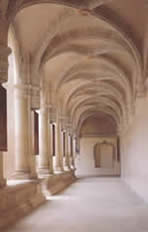 The Santo Domingo Cultural Center was the site for the second concert offered by the Ensamble Clérambault from México City, including Vincent Touzet, transverse flute, Norma García, harpsichord, and Gabriela Villa, viola da gamba, all of them renowned performers and professors in Mexico City
The Santo Domingo Cultural Center was the site for the second concert offered by the Ensamble Clérambault from México City, including Vincent Touzet, transverse flute, Norma García, harpsichord, and Gabriela Villa, viola da gamba, all of them renowned performers and professors in Mexico City 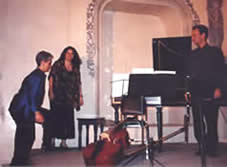 music conservatories. Their beautifully executed program of baroque music included works by Telemann, Bach, Rameau, Couperin and Locatelli in different combinations of the three instruments. The harpsichord used in this and other IOHIO concerts was built in Haarlem, the Netherlands, in 1991 by Fred Bettenhausen and is a replica of a double-manual instrument constructed by the French harpsichord builder Pascal Taskin in the mid-eighteenth century.
music conservatories. Their beautifully executed program of baroque music included works by Telemann, Bach, Rameau, Couperin and Locatelli in different combinations of the three instruments. The harpsichord used in this and other IOHIO concerts was built in Haarlem, the Netherlands, in 1991 by Fred Bettenhausen and is a replica of a double-manual instrument constructed by the French harpsichord builder Pascal Taskin in the mid-eighteenth century.
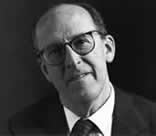 March 13 After waiting two years for Luigi Ferdinando Tagliavini to be able to come to Oaxaca, at last we had the opportunity to hear him play in Tlacochahuaya. His concert offered a panorama of seventeenth- and eighteenth-century organ music by
March 13 After waiting two years for Luigi Ferdinando Tagliavini to be able to come to Oaxaca, at last we had the opportunity to hear him play in Tlacochahuaya. His concert offered a panorama of seventeenth- and eighteenth-century organ music by
 Italian composers Storace, Frescobaldi, Pasquini, Scarlatti and Cimarosa, as well as the Spanish composer Bruna. Tagliavini is considered by many to be the world´s expert on this repertoire. The concert was riveting, and his interpretation of the sacred pieces verged on the sublime. The Tlacochahuaya organ is considered to be the jewel in the crown of restored Oaxacan instruments, due to the richness of its sound, its case beautifully decorated with multi-colored swirling floral designs, angel musicians, and faces on the façade pipes, and its location in one of Oaxaca´s loveliest sixteenth-century village churches.
Italian composers Storace, Frescobaldi, Pasquini, Scarlatti and Cimarosa, as well as the Spanish composer Bruna. Tagliavini is considered by many to be the world´s expert on this repertoire. The concert was riveting, and his interpretation of the sacred pieces verged on the sublime. The Tlacochahuaya organ is considered to be the jewel in the crown of restored Oaxacan instruments, due to the richness of its sound, its case beautifully decorated with multi-colored swirling floral designs, angel musicians, and faces on the façade pipes, and its location in one of Oaxaca´s loveliest sixteenth-century village churches.
 March 14 The second talk, “Girolamo Frescobaldi and Classic Italian Organ Practice,” encompassed rhythmic interpretation, ornamentation, and harmony in the sacred music of Frescobaldi. Tagliavini reminded us that the original purpose of these musical devices was to enhance the expression of emotions associated with the Passion of Christ. An accompanying musical demonstration was provided by José Suárez.
March 14 The second talk, “Girolamo Frescobaldi and Classic Italian Organ Practice,” encompassed rhythmic interpretation, ornamentation, and harmony in the sacred music of Frescobaldi. Tagliavini reminded us that the original purpose of these musical devices was to enhance the expression of emotions associated with the Passion of Christ. An accompanying musical demonstration was provided by José Suárez.
With this event, the Second Part of the Fourth Festival officially ended, but since Mr. Tagliavini stayed in Oaxaca for several more days, the IOHIO organized visits to other Oaxacan organs and to various tourist attractions.
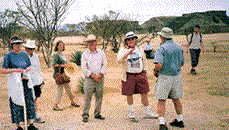
March 15 Dr. Marcus Winter, archaeologist in the INAH (Instituto Nacional de Antropología e Historia), took us to the archeological site of Monte Albán and the INAH laboratory located in the 16th century former convent of Cuilapan.
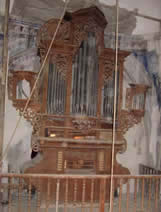
March 16 The following day, a day trip was organized to the Mixteca Alta region so that Tagliavini could see more Oaxacan organs. Our first stop was in San Mateo Yucucuí where we were enthusiastically received by a group of local officials and their wives. We climbed up the stone spiral staircase to the choir loft to admire the organ, but the precarious condition of the floor planks in the balcony prevented our getting a close view.
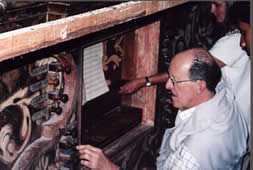
Several of our Yucucuí friends were able to accompany us to Yanhuitlán and join us in listening to Tagliavini play that organ.
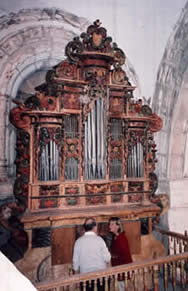
Our next visit was to the eighteenth-century organ of Santa María Tiltepec. This instrument was still in use just forty years ago and is unique among Oaxaca organs in its phonic layout, case design, decoration, and details of construction. It also possesses one of the most beautifully carved keyboards in Oaxaca. Our visitors from Yucucuí were most interested in seeing another unrestored organ in a neighboring town and in meeting the church custodian from Tiltepec whose interest in preserving the culture of his community is similar to theirs.
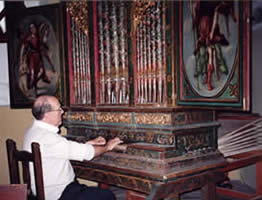
Our last stop of the day was Zautla where Tagliavini was able to play one more organ before departing Oaxaca.
Thanks to this field trip, Tagliavini was able to appreciate the different aspects of the work of the IOHIO, not only the musical aspect in the context of the festivals, but also the aspect of protection and conservation of the organs and our relations with the people in Oaxacan communities.
As in previous years, the concerts were filmed by the local television station (Corporación Oaxaqueña de Radio y Televisión or CORTV) and transmission of the concerts statewide began right alter the Festival. There is no better means of communication about the historic organs than these broadcasts, since the great majority of Oaxacans do not go to the concerts but they do see them on television.
The Fourth Festival was a great success and reinforced one of the principal goals of the IOHIO: to promote and publicize the Oaxacan historic organs. Our audience continues to grow each year and in fact,. many people from Mexico City and abroad have already expressed interest in participating in our Fifth Festival, tentatively scheduled for November 2005.
A review of the Fourth Festival Part II by art historian and festival participant Richard Perry may be accessed at http://www.colonial-mexico.com/Oaxaca/organs.html (en inglés)
The IOHIO is grateful for the support of the following institutions:
Consejo Nacional para las Artes y la Cultura (CONACULTA)
Instituto Nacional de Bellas Artes (INBA)
Instituto Nacional de Antropología e Historia (INAH)
Instituto Oaxaqueño de las Culturas (IOC)
Fideicomiso Oaxaca Sicarú, A.C.
Arquidiócesis de Oaxaca
Iglesia de Sta. María Tamazulapan
Centro Cultural Santo Domingo
Embajada de los Países Bajos en México
Instituto Italiano de Cultura
Universidad de Valladolid
Corporación Oaxaqueña de Radio y Televisión (CORTV)
Caminos y Puentes Federales (CAPUFE)
We are also grateful for the support of the following Oaxacan businesses:
Casa Colonial
Hotel Anturios
Hotel Azucenas
Hotel California
Hotel Casa Arnel
Hotel Casa Cue
Hotel de la Parra
Hotel Gala
Hotel Parador San Agustín
Hotel Perreya
Hotel Principal
Hostal de la Noria
Posada Catrina
Proveedora Gráfica de Oaxaca
Privacy Policy Copyright � 2024 Instituto de Órganos Históricos de Oaxaca, A.C. � Web Design by Ambidextro |